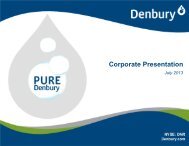Interactive 2009 Annual Report (PDF 7.56 MB) - Denbury Resources ...
Interactive 2009 Annual Report (PDF 7.56 MB) - Denbury Resources ...
Interactive 2009 Annual Report (PDF 7.56 MB) - Denbury Resources ...
- No tags were found...
You also want an ePaper? Increase the reach of your titles
YUMPU automatically turns print PDFs into web optimized ePapers that Google loves.
<strong>Denbury</strong> <strong>Resources</strong> Inc. <strong>2009</strong> <strong>Annual</strong> <strong>Report</strong> 9• Phases 7 and 8 will require completion of our 320-mile Green Pipeline, which will run from Southern Louisiana toHastings Field, south of Houston, Texas, and is scheduled for completion late 2010. Hastings Field, a field on whichwe acquired a purchase option late 2006 and purchased in February <strong>2009</strong>, is our Phase 7, the Seabreeze Complex(Oyster Bayou Field), acquired in 2007, will be our Phase 8. We expect to commence CO 2 injections at OysterBayou Field in mid-2010 and at Hastings field in early 2011.• Phase 9 is Conroe Field, acquired in December <strong>2009</strong>.Jackson Dome. In February 2001, we acquired approximately 800 Bcf of proved producing CO 2 reserves for $42million, a purchase that gave us control of most of the CO 2 supply in Mississippi, as well as ownership and control of acritical 183-mile CO 2 pipeline. This acquisition provided the platform to significantly expand our CO 2 tertiary recoveryoperations by assuring that CO 2 would be available to us on a reliable basis and at a reasonable and predictable cost.Since February 2001, we have acquired two wells and drilled 21 additional CO 2 producing wells, significantly increasingour estimated proved CO 2 reserves to approximately 6.3 Tcf as of December 31, <strong>2009</strong>, which is almost enough for ourexisting and currently planned phases of operations. The estimate of 6.3 Tcf of proved CO 2 reserves is based on 100%ownership of the CO 2 reserves, of which <strong>Denbury</strong>’s net ownership (net revenue interest) is approximately 5.0 Tcf and isincluded in the evaluation of proved CO 2 reserves prepared by DeGolyer and MacNaughton. In discussing our availableCO 2 reserves, we make reference to the gross amount of proved reserves, as this is the amount that is available bothfor <strong>Denbury</strong>’s tertiary recovery programs and for industrial users who are customers of <strong>Denbury</strong> and others, as<strong>Denbury</strong> is responsible for distributing the entire CO 2 production stream.Although our current proved and potential CO 2 reserves are quite large, in order to continue our tertiary developmentof oil fields in the area, incremental deliverability of CO 2 is required. In order to obtain additional CO 2 deliverability, wecontinued our exploration efforts by evaluating a 136-square-mile 3-dimensional seismic program during <strong>2009</strong>. The3-D seismic program, located west of the DRI Ice Field, was acquired during 2008 over existing known CO 2 fields andadjacent lead areas. We anticipate drilling three wells during 2010, one or two of which will be exploratory wells basedupon the interpretation of the seismic data. During <strong>2009</strong>, we drilled and completed one additional CO 2 production well.The <strong>2009</strong> well added approximately 340 Bcf of additional CO 2 reserves and increased our estimated Jackson Dometotal CO 2 production capacity to approximately 1.0 Bcf/d. Additional CO 2 reserves were added by acquiring additionalproved non-producing acreage over one of our existing fields. In addition to increasing our proved reserves by 0.9 Bcf(after the effect of <strong>2009</strong> production), and in order to ensure future production rates, processing capabilities anddeliverability to our fields, during <strong>2009</strong> we constructed a 150 MMcf/d dehydration facility, installed additional pumpcapacity at the Brandon Pump Station and constructed a 14-mile pipeline from the Barksdale dehydration facilityto the Brandon Pump Station. This 14-mile Brandon pipeline and pump station will provide additional capacity to thesouthern end of the NEJD Pipeline.During <strong>2009</strong>, we sold an average of 88 MMcf/d of CO 2 to commercial users, and we used an average of 595 MMcf/dfor our tertiary activities. We are continuing to increase our CO 2 production, which averaged 790 MMcf/d during thefourth quarter of <strong>2009</strong>, a 3% increase over the fourth quarter of 2008 production levels. We estimate that our plannedtertiary operations will not require any significant additional deliverability through 2010 above the production capacityof 1.0 Bcf/d.Man-made CO2 Sources. In addition to our natural source of CO 2 , we have entered into long-term contracts topurchase man-made CO 2 from eight proposed plants that will emit large volumes of CO 2 , four of which are in the GulfCoast region and four in the Midwest region (Illinois, Indiana and Kentucky.) The Midwest purchases are conditioned onboth the specific plant being constructed and <strong>Denbury</strong> contracting enough volumes of CO 2 for purchase in thegeneral area of our proposed Midwest pipeline system, such that an acceptable economic rate-of-return on the CO 2pipeline will be achieved. If all eight of these plants were to be built, these CO 2 sources are currently anticipated toprovide us with aggregate CO 2 volumes of 1.2 Bcf/d to 1.9 Bcf/d, although the earliest source of this man-made CO 2 isnot expected to be available to us until 2014. These plants have all been delayed due to current economic conditionsand there is some doubt as to whether they will be constructed at all. Several of these plants are seeking funds fromgovernment sources, which if secured, could increase the probability that the plants are ultimately constructed.The base price of CO 2 per Mcf from these CO 2 sources varies by plant and location, but is generally higher than ourmost recent “all-in” cost of CO 2 from our natural source (Jackson Dome) using current oil prices. Prices for CO 2Form 10-K Part I




